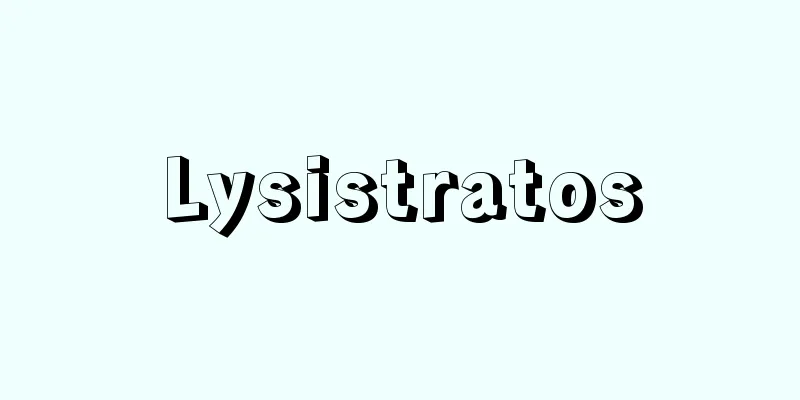Humorous book - Kokkeibon

|
A type of humorous comedy (gesaku) that is part of the genre of late Edo novels. At the time, they were called chuhon (similar to the current shinsho format) in contrast to sharebon (similar to the current bunko format), which was written in a style called kohon (small book) (similar to the current bunko format), but after the mid-Meiji period, when early modern literature became the subject of academic study, the name was unified according to the content. Its origins lie in the dangibon (discussion books) that were popular in Edo in the 1760s (Horeki era), which aimed to educate the common people and used a simple, humorous method of teaching in the tone of Buddhist sermons. His representative work, "Today's Incompetent Discussion" (1752, 53) by Jōkanbō Kōa, is a moral text that criticizes the decadent and over-ripe Edo culture in humorous terms, relying on the spirits of ancient people and anecdotes of modern people. This led to many similar works, including "A Miscellaneous Chest of Teachings" (1752) by Ito Tanpaku, but among these works, "Nenashigusa" (1763) and "Furyū Shidōkenden" (1763) by Hiraga Gennai, also known as Furaisanjin, stood out as being based on personal resentment and developed into satirical content rather than moral teaching. However, in Edo at that time, humorous works such as sharebon, kibyōshi, and kyōbun were at their peak, so dangibon were inevitably short-lived. In 1790 (Kansei 2), Matsudaira Sadanobu's Edict for the Pursuit of Public Morals destroyed humorous literature such as sharebon and kibyōshi. After that, the Nakamoto period, which depicted humorous aspects of everyday life, began, led by Jippensha Ikkū's "Hizakurige on the Tokaido Road" (first volume, 1802). Shikitei Sanba's "Ukiyo-buro" (first volume, 1808) and "Ukiyo-doko" (first volume, 1811), which meticulously depicted the humor of ordinary people's lives, were followed by other works such as "Ukiyo-buro" (first volume, 1808) and "Ukiyo-doko" (first volume, 1816), which depicted humorous aspects of ordinary people's lives. 1) The heyday of the genre was reached with the publication of Ryute Rijō's "Hanagoyomi Hasshōjin" (first volume, 1820) and "Wagoujin" (first volume, 1823), which depicted the leisurely lives of common people devoted to farce, and imitative works such as Baitei Kinka's "Shichihenjin" (first volume, 1857) and Kanagaki Robun's "Comedic Pilgrimage to Mt. Fuji" (first volume, 1860) also appeared. In the Meiji period, Robun's "Hizakurige: A Western Journey" and "Agura Nabe" were also published, but in 1872 (Meiji 5), the last Nakahon was published with Robun's "Tako no Nyudo Sakana Sermon," a piece of propaganda literature for the government's "Sanjo Instructions." [Kaname Okitsu] "Japanese Literature 5: The Blooming of Edo Citizen Literature" by Terunobu Yasutaka and Gunji Masakatsu (1967, Shibundo) " "Research on Fiction" by Nakano Mitsutoshi (1981, Chuokoron-Shinsha) "Literature at a Turning Point: From Edo to Meiji" by Okitsu Kaname (1960, Waseda University Press) Volume 1 by Hiraga Gennai ( Owned by the National Diet Library ) "The Tale of Elegant Shidoken" Written and illustrated by Jippensha Ikku, published in 1804 (Kyowa 4), held at the National Diet Library . "Hizakurige on the Tokaido Road" Source: Shogakukan Encyclopedia Nipponica About Encyclopedia Nipponica Information | Legend |
|
滑稽を目的とした戯作(げさく)類で、後期江戸小説の一分野。当時は、小本(こほん)(現在の文庫本に近い型)とよばれた書型の洒落本(しゃれぼん)に対して、中本(ちゅうほん)(現在の新書判に近い型)とよばれたが、明治中期以後、近世文学が学問の対象となってから、内容によって、この名称に統一された。源流は、1760年代(宝暦年間)に江戸で流行した談義本(だんぎぼん)類で、これらは、庶民教化を目的として、仏家の説法談義の調子で、平易、滑稽に教訓するという手法をとった。代表作の静観房好阿(じょうかんぼうこうあ)作『当世下手談義(いまようへただんぎ)』(1752、53)は、古人の霊や今人の逸話に託して、滑稽な表現で退廃爛熟(らんじゅく)した江戸文化を批判した教訓書である。そして伊藤単朴(たんぼく)作『教訓雑長持(ぞうながもち)』(1752)をはじめとする多くの類作が生まれたが、この系列のなかでは、風来山人(ふうらいさんじん)こと平賀源内の『根南志具佐(ねなしぐさ)』(1763)や『風流志道軒伝(しどうけんでん)』(1763)が、個人的憤懣(ふんまん)を基調とし、教訓よりも風刺的内容に発展して異彩を放った。しかし、当時の江戸では、洒落本、黄表紙、狂文など、滑稽をもっぱらとする作品が全盛を極めていたので、談義本は短命で終わらざるをえなかった。 1790年(寛政2)松平定信(さだのぶ)の風紀粛正令によって、洒落本、黄表紙などの笑いの文学が壊滅したのち、十返舎一九(じっぺんしゃいっく)の『東海道中膝栗毛(ひざくりげ)』(初編、1802)を先頭にして、市井(しせい)の滑稽な様相を描く中本時代が始まり、庶民生活のおかしみを綿密に描写する式亭三馬(しきていさんば)の『浮世風呂(ぶろ)』(初編、1808)、『浮世床』(初編、1811)、茶番に明け暮れる庶民の遊興生活を描く滝亭鯉丈(りゅうていりじょう)の『花暦八笑人(はなごよみはっしょうじん)』(初編、1820)、『滑稽和合人(わごうじん)』(初編、1823)も刊行されて全盛期を迎え、梅亭金鵞(ばいていきんが)の『七偏人(しちへんじん)』(初編、1857)や仮名垣魯文(かながきろぶん)の『滑稽冨士詣(ふじもうで)』(初編、1860)などの模倣的作品も出た。明治に入り、魯文の『西洋道中膝栗毛』や『安愚楽鍋(あぐらなべ)』なども刊行されたが、1872年(明治5)、政府の「三条の教則」の宣伝文学『蛸(たこ)之入道魚説教』(魯文)が最後の中本となった。 [興津 要] 『暉峻康隆・郡司正勝著『日本の文学5 江戸市民文学の開花』(1967・至文堂)』▽『中野三敏著『戯作研究』(1981・中央公論社)』▽『興津要著『転換期の文学――江戸から明治へ』(1960・早稲田大学出版部)』 巻1 平賀源内作国立国会図書館所蔵"> 『風流志道軒伝』 十返舎一九著・画 1804年(享和4)刊国立国会図書館所蔵"> 『東海道中膝栗毛』 出典 小学館 日本大百科全書(ニッポニカ)日本大百科全書(ニッポニカ)について 情報 | 凡例 |
<<: Kogge Ship - Koggesen (English spelling)
>>: Funny Chat - Funny Elephant
Recommend
Esodamashi - Esodamashi
...They are caught with bottom trawls and used as...
Mr. Uno
A group of Yamato warriors in the Heian and early ...
Ochi [town] - Ochi
A town in Takaoka County in central Kochi Prefectu...
Sorex minutissimus
…[Yoshiharu Imaizumi]. … *Some of the terminology...
method of exhaustion
…Archimedes seems to have been good at observatio...
Contharidus japonicus hilaris
…[Tadashige Nabe]. . … *Some of the terminology t...
Hargreaves, James
Born: January 8, 1721 (baptized) by Oswald Wissle ...
charanga
...Cuban dance music. It is a modern popular musi...
Ido Heizaemon
1672-1733 A samurai from the early to mid-Edo per...
local race
...Homogeneity is a comparative concept. There ar...
Genchu-ji Temple
This temple is located deep in the mountains at an...
Bolinus brandaris (English spelling) Bolinusbrandaris
…The flesh is edible. The mucus in the gills turn...
Ljulin
...Population: 1,117,000 (1996). Located in the w...
Oil wholesaler - Aburadoiya
A general term for oil wholesalers in the early mo...
Thomas Paine
A political commentator who contributed to the Am...









